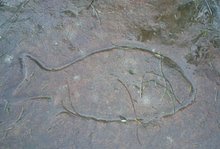 With reported salmonella infections surging in NSW and gastroenteritis reaching epidemic proportions again, it is time to look at the local 'mystery' disease.
With reported salmonella infections surging in NSW and gastroenteritis reaching epidemic proportions again, it is time to look at the local 'mystery' disease.
The latest outbreak has hit the Northern Beaches' sandy playgrounds. 23 children are suffering from Salmonella paratyphi bio var java, a bug associated with exotics in aquariums.Suburbs cleansed of Australian 'wildlife' only allow interaction-starved young humans to relate to animals as pets, held in captivity. Under the guise of education & child-care living creatures become the objects to form the attention skills of little ones.
After dogs & cats, exotic pets fuel rampant animal traffic and pet shops. Lifted out of their habitats, and/or raised in unsanitary crowded conditions, these exotic beings are then brought (mostly illegally) into the child's space. The exotic bugs come gratis. Reptiles and amphibians became fashionable recently due to their perceived low maintenance and cost effectiveness. ” During 2001--2006, the number of turtles kept as pets in the United States increased 86% to nearly 2 million turtles.” Both turtles and other reptiles are a cause of human Salmonella infection. In the US children in 33 states have become infected with this new emerging disease. “...Salmonella carried by small pet turtles has sickened more than 100 people and hospitalized at least 24 nationwide in the largest recorded outbreak of its kind...” Salmonella Paratyphi B var. Java has been found in most of the cases, “an exposure to turtles, other reptiles, or aquariums containing tropical fish.” was prevalent. In some instances the children were even sharing the unchlorinated pool with the turtle, for some it resulted in renal failure.
The Red-eared Slider (Trachemys scripta elegans) is one such popular pet turtle from the wet-lands of the United States. Popular with the animal trafficking industry, later as another costly invasive pest they are finding their way illegally into Australia, from Brisbane, Canberra, Gold Coast, Hobart and Melbourne. “The CDC has found that potentially fatal diseases such as monkeypox, salmonellosis, tularemia, and plague have been transmitted to people via imported animals such as squirrels, mice, lizards, snakes, and turtles.”
It would be sustainable to learn to share the world with the Australian animals,that still exist and interact by providing a long-term habitat for them and healthy young human beings, learning about ecology and interacting with peers in an intact environment. No invasive pests and no hurled alien bugsAnd more on beach sand...and E. coli
It has been found that bacteria from sewage ( Escherichia coli, fecal coliforms,  and enterococci) accumulates in the golden beach sand of Florida's shores. ” Results showed that wet sand (in the intertidal zone) and dry sand above the intertidal zone had significantly more fecal bacteria than near-shore seawater ”. Feces-derived bacteria actually continue to reproduce on the beach sand, wave action washes some back into the blue surf. Rolling on beach sand could harbour health risks.
and enterococci) accumulates in the golden beach sand of Florida's shores. ” Results showed that wet sand (in the intertidal zone) and dry sand above the intertidal zone had significantly more fecal bacteria than near-shore seawater ”. Feces-derived bacteria actually continue to reproduce on the beach sand, wave action washes some back into the blue surf. Rolling on beach sand could harbour health risks.
Let's not think about the untreated mess illegal dog-walkers leave behind on unsupervised beaches. Lucky, that Manly is girth by a vigilant water quality management.
More:
On Salmonella, CDC
Turtle-Associated Salmonellosis in Humans—United States, 2006–2007, CDC
Stop kissing that turtle, Barf 0908
Update:
280709 Beach sand fecal contamination and salmonella
260212 Salmonella in Sydney playgrounds, Mona Vale, Winnererremy Bay, S. Paratyphi B biovar Java exotic pets reptiles aquarium hygiene Multidrug-resistant Salmonella Java
06012015 Finally, the 'feel good solution' of blaming Australian native animals is here. Blame the last endemic bandicoots and turn a blind eye to pet feces and contaminated sand in which minors aggregate in large numbers (with their pets).
18 May 2008
Sand - Salmonella, E. coli and that cute pet
Tags
disease,
dog_owners,
invasive_species,
kids,
pests,
pets,
sand,
sewage
Subscribe to:
Post Comments (Atom)











No comments:
Post a Comment